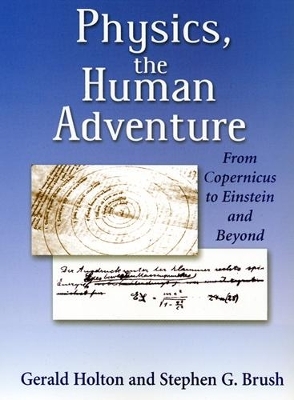
Physics, the Human Adventure
Rutgers University Press (Verlag)
978-0-8135-2908-0 (ISBN)
Winner of the 2001 Joseph Hazen Education Prize of the History of Science Society
Physics, the Human Adventure is the third edition of the classic text Introduction to Concepts and Theories in Physical Science. Authored by Gerald Holton, the text was a landmark in science education. It was the first modern textbook in physics (or in any other science) to make full and effective use of the history and philosophy of science in presenting for both the general and the science-oriented student an account of the nature of physical science. A second edition, prepared by Stephen G. Brush, brought the book up to date by increasing the coverage of topics in modern physics and by taking account of recent scholarly research in the history of science.
In the new book Physics, The Human Adventure, each of the chapters has been reworked to further clarify the physics concepts and to incorporate recent physical advances and research. The book shows the unifying power of science by bringing in connections to chemistry, astronomy, and geoscience. In short, the aid of the new edition is to teach good physics while presenting physical science as a human adventure that has become a major force in our civilization.
New chapters discuss theories of the origin of the solar system and the expanding universe; fission, fusion, and the Big Bang–Steady State Controversy; and thematic elements and styles in scientific thought. New topics include:
• Theories of vision: does the eye send out rays or receive them?
• Distances in the solar system
• The prediction of the return of Halley’s comet and analysis of deviations from Kepler’s laws
• Angular momentum conservation and Laplace’s nebular hypothesis
• Relation between symmetries and conservation laws: Emmy Noether’s theorem
• First estimates of atomic sizes
• Consequences of the indistinguishability of elementary particles of the same kind
• Applications of quantum mechanics to many-particle systems
• Dirac’s prediction of anti-matter
• The anthropic principle and other controversial issues on the frontiers of research
GERALD HOLTON is Mallinckrodt Professor of Physics and History of Science, Emeritus, Harvard University. STEPHEN G. BRUSH is Distinguished University Professor of the History of Science, University of Maryland, College Park. Both authors are Fellows of the American Physical Society, and each has served as President of the History of Science Society.
Preface
Part A. The Origins of Scientific Cosmology
Chapter 1. The Astronomy of Ancient Greece
Chapter 2. Copernicus' Heliocentric Theory
Chapter 3. On the Nature of Scientific Theory
Chapter 4. Kepler's Laws
Chapter 5. Galileo and the New Astronomy
Part B. The Study of Motion
Chapter 6. Mathematics and the Description of Motion
Chapter 7. Galileo and the Kinematics of Free Fall
Chapter 8. Projectile Motion
Part C. Newton's Laws and His System of the World
Chapter 9. Newton's Laws of Motion
Chapter 10. Rotational Motion
Chapter 11. Newton's Law of Universal Gravitation
Part D. Structure and Method in Physical Science
Chapter 12. On the Nature of Concepts
Chapter 13. On the Duality and Growth of Science
Chapter 14. On the Discovery of Laws
Part E. The Laws of Conservation
Chapter 15. The Law of Conservation of Mass
Chapter 16. The Law of Conservation of Momentum
Chapter 17. The Law of Conservation of Energy
Chapter 18. The Law of Dissipation of Energy
Part F. Origins of the Atomic Theory in Physics and Chemistry
Chapter 19. The Physics of Gases
Chapter 20. The Atomic Theory of Chemistry
Chapter 21. The Periodic Table of Elements
Chapter 22. The Kinetic-Molecular Theory of Gases
Part G. Light and Electromagnetism
Chapter 23. The Wave Theory of Light
Chapter 24. Electrostatics
Chapter 25. Electromagnetism, X-Rays, and Electrons
Chapter 26. The Quantum Theory of Light
Part H. The Atom and the Universe in Modern Physics
Chapter 27. Radioactivity and the Nuclear Atom
Chapter 28. Bohr's Model of the Atom
Chapter 29. Quantum Mechanics
Chapter 30. Einstein's Theory of Relativity
Chapter 31. The Origin of the Solar System and the Expanding Universe
Chapter 32. Construction of the Elements and the Universe
Chapter 33. Thematic Elements and Style in Science
Appendixes
General Bibliography
Credits
Index
| Erscheint lt. Verlag | 31.3.2001 |
|---|---|
| Zusatzinfo | 200 |
| Verlagsort | New Brunswick NJ |
| Sprache | englisch |
| Maße | 178 x 254 mm |
| Gewicht | 1049 g |
| Themenwelt | Naturwissenschaften ► Physik / Astronomie ► Angewandte Physik |
| ISBN-10 | 0-8135-2908-5 / 0813529085 |
| ISBN-13 | 978-0-8135-2908-0 / 9780813529080 |
| Zustand | Neuware |
| Haben Sie eine Frage zum Produkt? |
aus dem Bereich


